The NVIDIA GeForce GTX 780 Ti Review
by Ryan Smith on November 7, 2013 9:01 AM ESTOverclocking
Finally, let’s spend a bit of time looking at the overclocking prospects for the GTX 780 Ti. Although GTX 780 Ti is now the fastest GK110 part, based on what we've seen with GTX 780 and GTX Titan there should still be some headroom to play with. Meanwhile there will also be the matter of memory overclocking, as 7GHz GDDR5 on a 384-bit bus presents us with a new baseline that we haven't seen before.
| GeForce GTX 780 Ti Overclocking | ||||
| Stock | Overclocked | |||
| Core Clock | 876MHz | 1026MHz | ||
| Boost Clock | 928MHz | 1078MHz | ||
| Max Boost Clock | 1020MHz | 1169MHz | ||
| Memory Clock | 7GHz | 7.6GHz | ||
| Max Voltage | 1.187v | 1.187v | ||
Overall our overclock for the GTX 780 Ti is a bit on the low side compared to the other GTX 780 cards we’ve seen in the past, but not immensely so. With a GPU overclock of 150MHz, we’re able to push the base clock and maximum boost clocks ahead by 17% and 14% respectively, which should further extend NVIDIA’s performance lead by a similar amount.
Meanwhile the inability to unlock a higher boost bin through overvolting is somewhat disappointing, as this is the first time we’ve seen this happen. To be clear here GTX 780 Ti does support overvolting – our card offers up to another 75mV of voltage – however on closer examination our card doesn’t have a higher bin within reach; 75mV isn’t enough to reach the next validated bin. Apparently this is something that can happen with the way NVIDIA bins their chips and implements overvolting, though this the first time we’ve seen a card actually suffer from this. The end result is that it limits our ability to boost at the highest bins, as we’d normally have a bin or two unlocked to further increase the maximum boost clock.
As for memory overclocking, we were able to squeeze out a bit more out of our 7GHz GDDR5, pushing our memory clock 600MHz (9%) higher to 7.6GHz. Memory overclocking is always something of a roll of the dice, so it’s not clear here whether this is average or not for a GK110 setup with 7GHz GDDR5. Given the general drawbacks of a wider memory bus we wouldn’t be surprised if this was average, but at the same time in practice GK110 cards haven’t shown themselves to be as memory bandwidth limited as GK104 cards. So 9%, though a smaller gain than what we’ve seen on other cards, should still provide GTX 780 Ti with enough to keep the overclocked GPU well fed.
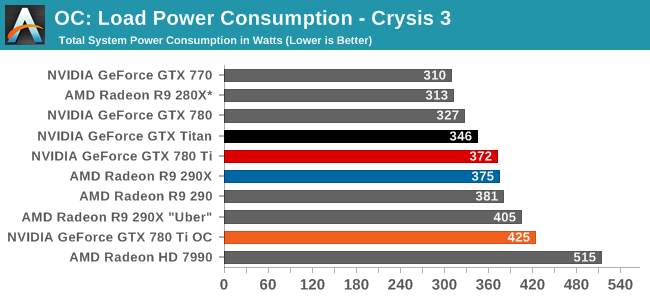
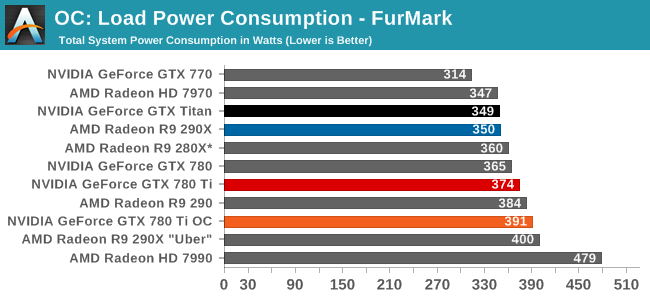
Starting as always with power, temperatures, and noise, we can see that overclocking GTX 780 Ti further increases its power consumption, and to roughly the same degree as what we’ve seen with GTX 780 and GTX Titan in the past. With a maximum TDP of just 106% (265W) the change isn’t so much that the card’s power limit has been significantly lifted – as indicated by FurMark – but rather raising the temperature limit virtually eliminates temperature throttling and as such allows the card to more frequently stay at its highest, most power hungry boost bins.
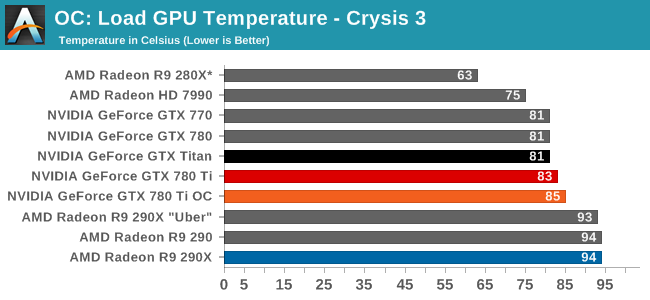

Despite the 95C temperature target we use for overclocking, the GTX 780 Ti finds its new equilibrium point at 85C. The fan will ramp up long before it allows us to get into the 90s.
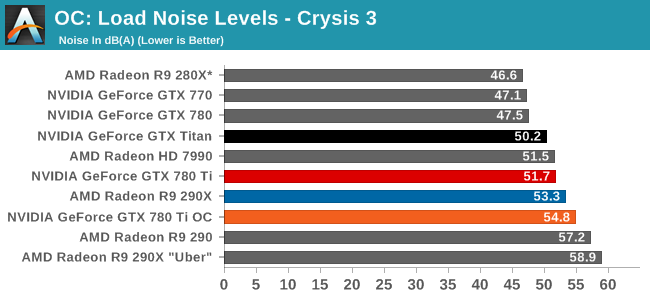
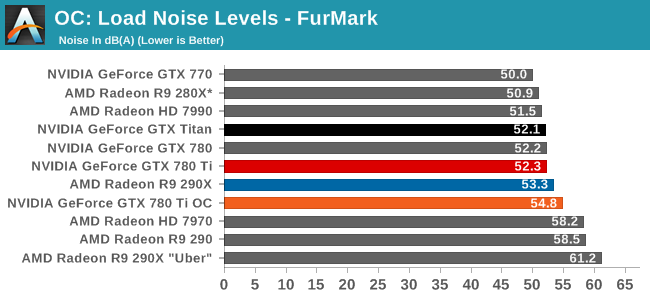
Given the power jump we saw with Crysis 3 the noise ramp up is surprisingly decent. A 3dB rise in noise is going to be noticeable, but even in these overclocked conditions it will avoid being an ear splitting change. To that end overclocking means we’re getting off of GK110’s standard noise efficiency curve just as it does for power, so the cost will almost always outpace the payoff on a relative basis.
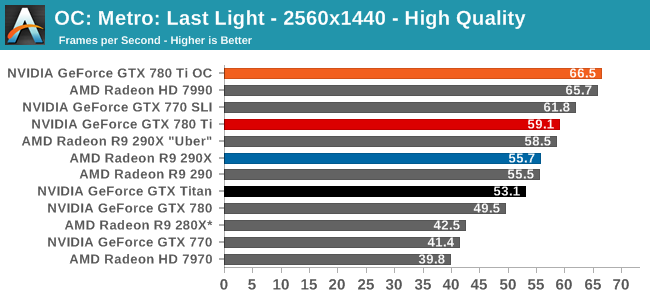
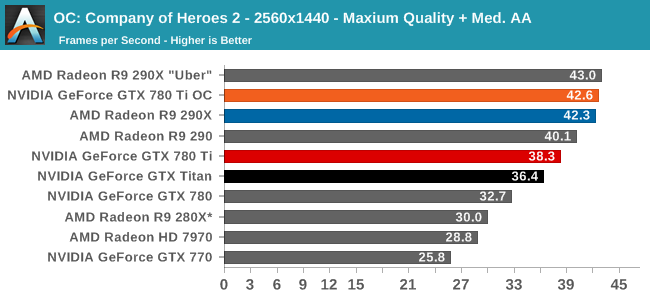
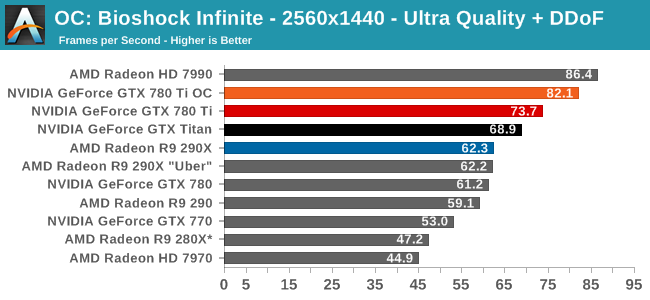
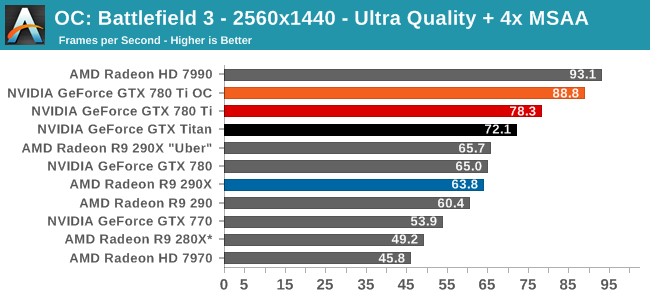
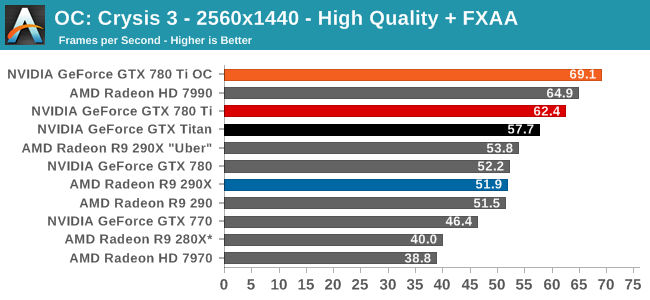
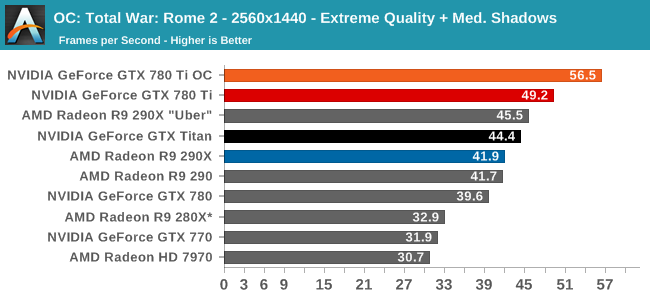
Finally, looking at gaming performance the the overall performance gains for overclocking are generally consistent. Between our 6 games we see a 10-14% performance increase, all in excess of the memory overclock and closely tracking the GPU overclock. GTX 780 Ti is already the fastest single-GPU card, so this only further improves its performance lead. But it does so while cutting into whatever is above it, be it the games where the stock 290X has a lead, or multi-GPU setups such as the 7990.










302 Comments
View All Comments
fewafwwaefwa - Thursday, November 7, 2013 - link
sterven.looncraz - Thursday, November 7, 2013 - link
When game producers author the games they will do it with a mind towards Mantle and exploiting the AMD GPU characteristics exposed by Mantle on PCs for their console games.When creating portable software you create as thin of an abstraction layer as possible, that layer will now be much closer to the metal with unoptimized DirectX alternatives being manually added. That could very well mean that AMD hardware will have a noticeable advantage on PCs and game producers will only need to do a little extra work to become compatible with other DX-10/11 compatible video cards on Windows/Linux - so nVidia will become something of a "don't forget about me!" rather than "let's build to a generic platform and pull in the nVidia GPU extensions..."
Basstrip - Friday, November 8, 2013 - link
I think they've ALWAYS programmed directly to the core. I think it's safe to assume that the processes translate fairly well and that although they might not be the same, they are similar.It just seems so economic to streamline the whole process. Less of a headache than to constantly try optimize things for multiple platforms.
AMD chips on consoles may not be able to support mantle on the hardware side but programming for consoles and for pc will definitely NOT be 2 completely different things.
elajt_1 - Friday, November 8, 2013 - link
Something I read on Extremetech: Feedback we’ve gotten from other sources continues to suggest that Microsoft’s low-level API for the Xbox One is extremely similar to Mantle, and the difference between the two is basically semantic. This doesn’t square very well with Microsoft’s own statements; we’ll continue to investigate.http://www.extremetech.com/gaming/168671-xbox-one-...
klmccaughey - Monday, November 11, 2013 - link
The difference is a couple of header files. Izzy Wizzy! And you have your API calling code in Xbox transferable to a PC, the header files compile the API's to Mantle API - but both API's are essentailly the same. It couldn't be easier.polaco - Friday, November 8, 2013 - link
The point of mantle I think is to provide an easy way to port from PC to console or Console to PC. So giving the possibility to allow an easier cross compilation.L33T BEANS - Friday, November 8, 2013 - link
Basing someones intelligence on a single statement is unwise.Totally - Sunday, November 10, 2013 - link
Reading these comments makes me wonder, if these people slinging mantle around like a buzzword actually know what it does, because going by the comments alone trying to pitting it against g-sync they clearly don't. Mantle is as relevant to gamers as Cuda is. Yes it does have a direct impact but the benefits aren't for the end user.klmccaughey - Monday, November 11, 2013 - link
You do not understand. The API on the consoles is basically "Mantle". Mantle copies verbatim the API calls for the consoles. They just call it the API on the console. Port the code across, change a few headers, and you have your Mantle calls ;)MonkeyM - Sunday, November 10, 2013 - link
They will sell DIY kits, you don't need a new monitor, as per the press conference.